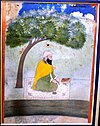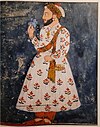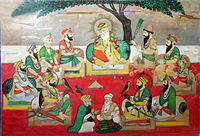Sikh gurus
| Part of a series on |
| Sikhism |
|---|
 |
The Sikh gurus (Punjabi: ਸਿੱਖ ਗੁਰੂ; Hindi: सिख गुरु) are the spiritual masters of Sikhism, who established the religion over the course of about two and a half centuries, beginning in 1469.[2] The year 1469 marks the birth of Guru Nanak, the founder of Sikhism. He was succeeded by nine other human gurus until, in 1708, the Guruship was finally passed on by the tenth guru to the holy Sikh scripture, Guru Granth Sahib, which is now considered the living Guru by the followers of the Sikh faith.[3] The guruship was also passed onto the Guru Panth, consisting of the Khalsa, however this means of guruship went into decline following to rise of Maharaja Ranjit Singh.[4][5]
Etymology and definition
[edit]Guru (/ˈɡuːruː/, UK also /ˈɡʊruː, ˈɡʊər-/; Sanskrit: गुरु, Punjabi: ਗੁਰੂ, IAST: guru) is a Sanskrit term for a "teacher, guide, expert, or master" of certain knowledge or field.[6] Bhai Vir Singh, in his dictionary of Guru Granth Sahib describes the term Guru as a combination of two separate units: "Gu;(ਗੁ)" meaning darkness and "Rū;(ਰੂ)" which means light.[7] Hence, Guru is who brings light into darkness or in other words, the one who enlightens. Bhai Vir Singh's definition provides further insight about Sikhi itself and explains why Guru Granth Sahib is considered the living Guru. The word Sikh is derived from the Sanskrit term shishya[8] (Punjabi: ਸਿੱਖ) which means a disciple or a student. Thus, Sikhs have a student–teacher relationship with their Gurus since their teachings, written in Guru Granth Sahib, serve as a guide for the Sikhs.
According to Sikh beliefs, all the Gurus contained the same light or soul and their physical body was a vessel for containing the same essence. When one Guru passed, the successor inherited this light and that is why the Gurus are also referred to as mahalla (house).[9]
The gurus
[edit]| No. | Name | Portrait | Birth date | Guruship | Birthplace | Clan | Father | Mother | Date of death | Reason | Place of death |
|---|---|---|---|---|---|---|---|---|---|---|---|
| 1 | Guru Nanak | 
|
14 April 1469 [note 1] | Since birth | Nankana Sahib, Punjab, Delhi Sultanate | Bedi Khatri | Kalyan Das Bedi | Mata Tripta | 22 September 1539 (aged 70) | Natural causes | Kartarpur, Punjab, Mughal Empire |
| 2 | Guru Angad | 
|
31 March 1504 | 7 September 1539 | Muktsar, Punjab, Mughal Empire | Trehan Khatri | Baba Pheru Mal | Mata Ramo | 29 March 1552 (aged 47) | Natural causes | Khadur Sahib, Punjab, Mughal Empire |
| 3 | Guru Amar Das | 
|
5 May 1479 | 26 April 1552 | Amritsar, Punjab, Mughal Empire | Bhalla Khatri | Tej Bhan Bhalla | Mata Lachmi | 1 September 1574 (aged 95) | Natural causes | Goindval, Lahore Subah, Mughal Empire |
| 4 | Guru Ram Das | 
|
24 September 1534 | 1 September 1574 | Lahore, Punjab, Mughal Empire | Sodhi Khatri | Baba Har Das | Mata Daya | 1 September 1581 (aged 46) | Natural causes | Goindval, Lahore Subah, Mughal Empire |
| 5 | Guru Arjan | 
|
15 April 1563 | 1 September 1581 | Goindval, Punjab, Mughal Empire | Sodhi Khatri | Guru Ram Das | Mata Bhani | 30 May 1606 (aged 43) | Execution by Mughal Emperor Jahangir | Lahore, Lahore Subah, Mughal Empire |
| 6 | Guru Hargobind | 
|
19 June 1595 | 25 May 1606 | Amritsar, Lahore Subah, Mughal Empire | Sodhi Khatri | Guru Arjan | Mata Ganga | 28 February 1644 (aged 48) | Natural causes | Kiratpur Sahib, Lahore Subah, Mughal Empire |
| 7 | Guru Har Rai | 
|
16 January 1630 | 3 March 1644 | Kiratpur Sahib, Lahore Subah, Mughal Empire | Sodhi Khatri | Baba Gurditta | Mata Nihal Kaur | 6 October 1661 (aged 31) | Natural causes | Delhi, Delhi Subah, Mughal Empire |
| 8 | Guru Har Krishan | 
|
7 July 1656 | 7 October 1661 | Kiratpur Sahib, Lahore Subah, Mughal Empire | Sodhi Khatri | Guru Har Rai | Mata Krishan Kaur | 30 March 1664 (aged 7) | Smallpox | Delhi, Delhi Subah, Mughal Empire |
| 9 | Guru Tegh Bahadur | 
|
1 April 1621 | 20 March 1664 | Amritsar, Lahore Subah, Mughal Empire | Sodhi Khatri | Guru Hargobind | Mata Nanaki | 11 November 1675 (aged 54) | Execution by Mughal Emperor Aurangzeb | Delhi, Delhi Subah, Mughal Empire |
| 10 | Guru Gobind Singh | 
|
14 February 1666 | 11 November 1675 | Patna Sahib, Bihar Subah, Mughal Empire | Sodhi Khatri | Guru Tegh Bahadur | Mata Gujri | 7 October 1708 (aged 41) | Assassinated by Jamshed Khan and Wasil Beg on order of Wazir Khan | Hazur Sahib, Bidar Subah, Mughal Empire |
| 11 | Guru Panth[4][10][11][5] | 
|
Vaisakhi, April 1699[12] | Kesgarh Qila, Anandpur Sahib, Punjab[13] | Casteless[14][15] | Guru Gobind Singh (spirtually)[4] | Mata Sahib Devan (spiritually)[16] | Whilst prevalent in the 18th century, this manner of guruship went into decline following the rise of Ranjit Singh and is seldom evoked today, being overshadowed by the Guru Granth.[4] | |||
| 12 | Guru Granth Sahib | 
|
29 August 1604 (date of completion of compilation of the first draft [Adi Granth]) |
20 October 1708 | Amritsar, Lahore Subah, Mughal Empire (place of compilation) |
The central holy scripture of Sikhism, regarded as the final, sovereign and eternal Guru. | |||||
Timeline
[edit]
Pedigrees
[edit]
See also
[edit]Notes
[edit]- ^ Officially observed on Katak Puranmashi (October–November)
- ^ Listed names and relations might vary from source to source since different aspects of Sikh history have been written by many different individuals over the course of past six centuries
References
[edit]- ^ The Sikhs. E.J. Brill. p. 38. ISBN 9004095543.
- ^ Sen, Sailendra (2013). A Textbook of Medieval Indian History. Primus Books. pp. 186–187. ISBN 978-9-38060-734-4.
- ^ The Sikhs : faith, philosophy & folk. Lustre Press. 1998. ISBN 978-8174360373.
- ^ a b c d McLeod, W. H. (24 July 2009). The A to Z of Sikhism. Scarecrow Press. pp. 84–86. ISBN 9780810863446.
Guru Gobind Singh is traditionally believed to have announced that the personal transmission would end at his death, but that the mystical Guru would remain embodied in the scripture and the corporate Panth. ... GURU PANTH. The Guru Panth was a doctrine particularly suited to the circumstances of the 18th century, providing an effective means of decision making for Sikhs who were divided into several misls. When unification was achieved under Ranjit Singh the practice of eliciting corporate decisions from the Panth was discarded. The doctrine is still maintained today, and efforts are occasionally made to seek the Guru's will by this means. It is, however, seldom invoked. The voice of the Guru is much more commonly sought through the words of the Guru Granth.
- ^ a b "Sikh Reht Maryada - Other Rites and Conventions: Guru Panth (Panth's Status of Guruhood)". Shiromani Gurdwara Parbandhak Committee. Retrieved 18 December 2024.
- ^ Stefan Pertz (2013), The Guru in Me - Critical Perspectives on Management, GRIN Verlag, ISBN 978-3638749251, p. 2–3.
- ^ Singh, Veer (1964). Sri Guru Granth Kosh. p. 122.
- ^ Parrinder, Geoffrey (30 August 1983). World religions : from ancient history to the present. Facts on File. ISBN 978-0-87196-129-7.
- ^ Grewal, J. S.; Habib, Irfan, eds. (2001). Sikh History from Persian Sources: Translations of Major Texts. Indian History Congress. Session. New Delhi: Tulika. p. 5. ISBN 81-85229-17-1. OCLC 47024480.
The author of the Dabistan refers to the belief of the Sikhs in the unity of Guruship. The spirit of Guru Nanak entered the bodies of his successors - Guru Angad, Guru Amar Das, Guru Ram Das and Guru Arjan. That was why each Guru was referred to as mahal: Guru Nanak as the first mahal, Guru Angad as the second mahal, and in this way Guru Arjan as the fifth mahal. A Sikh who does not regard Guru Arjan as Baba Nanak is not a true Sikh. The firm belief of the Sikhs is that all the Gurus are Nanak. Indeed, Bhai Gurdas underscores the unity of Guruship from Guru Nanak to Guru Hargobind in one of his Vaars. This is reiterated in another Vaar in which the metaphors of light and water are used to emphasize that they all are the same.The idea of the unity of Guruship emphasized by Bhai Gurdas legitimized the succession of Guru Hargobind to face the rival claim of Prithi Chand and his descendants.
- ^ Sikh Rehat Maryada: Section Six, Chapter XIII, Article XXIII, a.
- ^ Singh, Sikandar (2012). Sikh heritage : ethos & relics. Roopinder Singh, Paul Michael Taylor. New Delhi. pp. 21, 23. ISBN 978-81-291-1983-4. OCLC 828612294.
The ten Gurus organised their disciples into sangats and infused their personality again into the Sikhs. This led to a remarkable development in the institution of 'Guru-ship', which eventually became the Guru Panth, thus bestowing divinity on the people. ... The Sikh assemblies also acquired great sanctity, owing to the belief that the spirit of the Guru lived and moved among them collectively, the whole body being called the panth. This panth follows the path shown by the way the Gurus lived their lives, as also the precepts laid down by them. In turn, it is regarded as an embodiment of the Guru—Guru Panth. In 1699, Guru Gobind Singh, the tenth Guru, himself received baptism from the five Sikhs he had first initiated. The panth, the assembly and the Guru became one. After his demise, there was no living Guru for the Sikhs. The Shabad, in the presence of the sangat, became the Guru, the guiding light and in presence of Akalpurakh, the Timeless Being. The panth thus was invested with the personality of the Guru, and the incorporated Word became Gyan Guru (knowledge). This panth, called the Khalsa, was to be the Guru in spirit, and was authorised to work with collective responsibility, with Guru Granth Sahib as its guiding spirit.
{{cite book}}: CS1 maint: location missing publisher (link) - ^ Tatla, Darsham Singh (8 August 2005). The Sikh Diaspora: The Search For Statehood. Routledge. p. 281. ISBN 9781135367442.
- ^ Dowley, Tim (1 June 2019). A Brief Introduction to Jainism and Sikhism. Fortress Press. p. 102. ISBN 9781506450391.
- ^ Singh, Nikky-Guninder Kaur (2004). O'Brien, Joanne; Palmer, Martin (eds.). World Religions: Sikhism. Infobase Publishing. p. 87. ISBN 9781438117799.
- ^ Dowley, Tim (1 July 2018). Partridge, Christopher (ed.). A Short Introduction to World Religions. Fortress Press. p. 308. ISBN 9781506446028.
- ^ Singh, Nikky-Guninder Kaur (1 February 2012). The Birth of the Khalsa: A Feminist Re-Memory of Sikh Identity (illustrated ed.). State University of New York Press. p. 37. ISBN 9780791482667.



